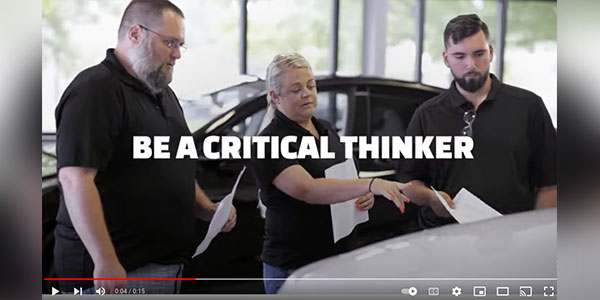More Cars on the Road + Fewer Dealers = More Opportunity!
You’re competing with the aftermarket like never before. The question is, will you aggressively go after these customers or simply stand by waiting for them to show up? If you stand around waiting, you will most definitely give the aftermarket a significant pay raise.
What Is Your Marketing Plan?
It’s not good enough to just “get more customers in the door.” The basic principle for you to consider is — what are you going to do with the customers when they do come in the door? The answer lies within your Rules of Engagement.
These are basic rules that have been around for a very long time, yet when my fixed operations specialists go to their dealerships to conduct an in-depth profit potential analysis and performance evaluation of their fixed operations processes (rules) we see that some of the rules are either not being followed or are not being used at all.
With that being said, what are the rules and, more importantly, why are they not being followed?
Rule No. 1: Offer an Appointment to 100% of the Incoming Service Calls
This certainly sounds simple enough, right? I mean, why would you not want to offer an appointment to every customer? Well, research shows that service advisors do not offer an appointment to 57% of their customers who are calling about a service concern or need.
So, you initiate a marketing plan. The plan works well and the phone starts ringing. Your service advisors answer the calls and six out of 10 callers are not given the opportunity to say “yes” to an appointment! Why? The answer is your advisors have not been properly trained on how to sell appointments.
This is why you should phone-shop every advisor or start listening to those recordings you have of incoming calls. The best solution is to take the incoming calls away from the service advisors and hire an appointment coordinator (with no bad habits) to take all incoming service calls.
Rule No. 2: Conduct a Vehicle Walk-Around with Each Customer
This process is well received by the vast majority of your customers, yet far too many service advisors wait for the customer to come to them for the write up. Why? Again, they probably have not been properly trained or forgive me for being blunt, they are lazy.
Your service advisors must go to the vehicle with the customer, walk around the vehicle looking for obvious signs of needed maintenance while building a positive rapport with the customer, note any damages found and make service recommendations to the customer (wiper blades, light bulbs, alignments, tires, etc.). It’s also called selling.
Your service advisors need to get the mileage reading anyway, so why not get the customer involved? Many service advisors consider themselves to be clerks versus salespeople. If you would like to know whether you have clerks or salespeople, just ask your advisors, or of course you could track their performance every day.
Rule No. 3: Present a Maintenance Menu when Writing the RO
Nothing new here! Gosh, I even had menus to present back in the ’70s when I was a service advisor. (My, how time flies when you’re having fun!) If it makes sense to give menu presentations in your finance departments then why would it not make sense to do so in your service department?
If you present menus in finance to increase your gross per retail unit then why would you not present menus in your service department to increase your sales per RO? Your F&I customers are not aware of all the products and services you may offer so you present them with a menu. The same holds true for your service customers, since most of them have no clue whatsoever about preventive maintenance requirements and/or recommendations. So, you must present them with a menu. Clerks do not like presenting menus since it seems like they are trying to sell something, which of course clerks do not do.
Professionally trained service advisors (salespeople) know that it is in the best interests of their customers to ensure their vehicles are properly maintained. In doing so these salespeople will increase your hours per RO by about three-tenths of an hour.
Rule No. 4: Complete a Vehicle Health Check (VHC) with every RO
Most dealers complete an inspection of some kind on every used vehicle they retail. Why? My belief is that they want to make sure the vehicle is safe and reliable for their customers. They also would like to maximize their gross PRU and they value their reputation in the community as well. When the inspection is completed, the used car manager usually has the final say on what repairs will be made and approves the final cost.
Sound familiar? If so, then I’m sure you will agree that it’s equally important for dealers to establish this rule for all of their service customers. After all, isn’t it important to ensure your customers are driving safe and reliable vehicles? Wouldn’t every dealer like to maximize their gross per RO and have a reputation in their community for providing excellent service?
The process is the same for the retail customer as it is for the used car manager. Inspect the vehicle, advise the customer on what’s needed, present an estimate, let the customer have the final say on what repairs or services will be completed and approve the final cost. Sounds like a simple plan to me.
So, why do so many dealers fail to complete a Vehicle Health Check for their customers at no charge? Answer: the technicians do not want to perform the VHC because the service clerks won’t sell (don’t know how or don’t want to) the recommended repairs or services. Properly present the results of the VHC to every customer and watch your sales increase by another .7 HPRO.
Rule No. 5: Perform an Active Delivery to the Customer
“Mr. Customer, you’re all set, the cashier has your keys and your final bill. Have a nice day.” Have you ever heard that in your store? Is it the cashier’s responsibility to explain the work that was completed and what the final costs are? I hope you said “No.”
Another way of explaining active delivery is valet service. Always bring the vehicle to the customer and never send the customer out the door to search for their vehicle.
Your service advisor should review the three C’s on the RO with the customer, explain the costs and set their next appointment. If you are interested in saving some money you might even consider eliminating the cashier’s position and let the advisor perform that function during the active delivery. Rule No. 5 will definitely have a positive effect on your CSI and owner retention.
It is vitally important that every employee in your dealership understand what a rule is. Here is the dictionary’s definition: “A principle or regulation governing conduct, action, procedure, etc.” Now, I have identified the 5 Rules of Engagement for your service team and your customers.
Don’t you think it’s about time you held everyone accountable for following the rules?
Don Reed, CEO DealerPRO Training














